Dell 0C547MA00, C547M, PP40L User Manual

SETUP GUIDE


SETUP GUIDE
Model PP40L

Notes, Cautions, and Warnings
 NOTE: A NOTE indicates important information that helps you make better use of your computer.
NOTE: A NOTE indicates important information that helps you make better use of your computer.
CAUTION: A CAUTION indicates either potential damage to hardware or loss of data and tells you how to avoid the problem.
 WARNING: A WARNING indicates a potential for property damage, personal injury, or death.
WARNING: A WARNING indicates a potential for property damage, personal injury, or death.
If you purchased a Dell™ n Series computer, any references in this document to Microsoft® Windows® operating systems are not applicable.
__________________
Information in this document is subject to change without notice. © 2009 Dell Inc. All rights reserved.
Reproduction of these materials in any manner whatsoever without the written permission of Dell Inc. is strictly forbidden.
Trademarks used in this text: Dell, the DELL logo, YOURS IS HERE, and DellConnect are trademarks of Dell Inc.; Intel, Pentium, and Celeron are registered trademarks and Core is a trademark of Intel Corporation in the United States and/or other countries; Microsoft, Windows, Windows Vista, and Windows Vista start button logo are either trademarks or registered trademarks of Microsoft Corporation in the United States and/or other countries; Bluetooth is a registered trademark owned by Bluetooth SIG, Inc. and is used by Dell under license.
Other trademarks and trade names may be used in this document to refer to either the entities claiming the marks and names or their products. Dell Inc. disclaims any proprietary interest in trademarks and trade names other than its own.
February 2009 P/N C547M Rev. A00
Contents
Setting Up Your Studio Laptop 5
Before Setting Up Your Computer |
5 |
Connect the AC Adapter |
6 |
Connect the Network Cable (Optional) |
7 |
Press the Power Button |
7 |
Microsoft® Windows Vista® Setup |
8 |
Installing the SIM (Optional) |
8 |
Enable or Disable Wireless (Optional) |
10 |
Connect to the Internet (Optional) |
11 |
Using Your Studio Laptop 14
Right Side Features 14 Left Side Features 18
Computer Base and Keyboard
Features 20 Touch Pad Gestures 22 Media Controls 24
Display Features 26
Removing and Replacing the
Battery 27 Software Features 28
Solving Problems 31
Beep Codes 31 Network Problems 32 Power Problems 33 Memory Problems 34 Lockups and Software Problems 35
Using Support Tools 38
Dell Support Center 38 System Messages 39 Hardware Troubleshooter 41 Dell Diagnostics 41
3
Contents
Restoring Your Operating System 44
System Restore 44 Dell Factory Image Restore 45 Operating System Reinstallation 47
Getting Help 49
Technical Support and Customer
Service 50 DellConnect™ 50 Online Services 51 Automated Order-Status Service 52 Product Information 52
Returning Items for Repair Under
Warranty or for Credit 53 Before You Call 54 Contacting Dell 55
Finding More Information and
Resources 56 Specifications 58
4
Appendix 66
Macrovision Product Notice 66
Index 67

Setting Up Your Studio Laptop
This section provides information about setting up your Studio 14z laptop and connecting peripherals.
Before Setting Up Your Computer
When positioning your computer, ensure that you allow easy access to a power source, adequate ventilation, and a level surface to place your computer.
Restricting airflow around your Studio laptop may cause it to overheat. To prevent overheating ensure that you leave at least
10.2 cm (4 inches) at the back of the computer and a minimum of 5.1 cm (2 inches) on all other sides. You should never place your computer in an enclosed space, such as a cabinet or drawer when it is powered on.
WARNING: Do not block, push objects into, or allow dust to accumulate in the air vents. Do not store your Dell™
computer in a low-airflow environment, such as a closed briefcase, while it is powered on. Restricting the airflow can damage the computer or cause a fire. The computer turns on the fan when the computer gets hot. Fan noise is normal and does not indicate a problem with the fan or the computer.
CAUTION: Placing or stacking heavy or sharp objects on the computer may result in permanent damage to the computer.
5
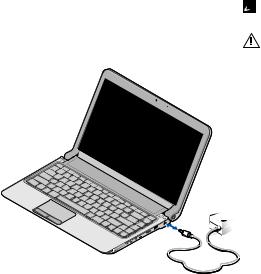
Setting Up Your Studio Laptop
Connect the AC Adapter
Connect the AC adapter to the computer and then plug it into an electrical outlet or surge protector.
6
 NOTE: Use only Dell AC adapter family PA-2E or PA-12 with your computer.
NOTE: Use only Dell AC adapter family PA-2E or PA-12 with your computer.
WARNING: The AC adapter works with electrical outlets worldwide. However, power connectors and power strips vary among countries. Using an incompatible cable or improperly connecting the cable to a power strip or electrical outlet may cause fire or permanent damage to your computer.
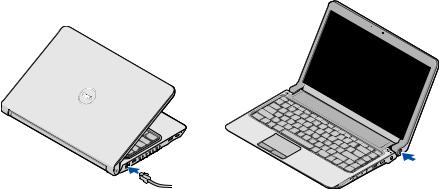
|
Setting Up Your Studio Laptop |
Connect the Network Cable |
Press the Power Button |
(Optional) |
|
To use a wired network connection, connect the network cable.
7

Setting Up Your Studio Laptop
Microsoft® Windows Vista® Setup
Your Dell computer is preconfigured with Windows Vista. To set up Windows Vista for the first time, follow the instructions on the screen. These steps are mandatory and may take up to 15 minutes to complete. The screens will take you through several procedures including accepting license agreements, setting preferences, and setting up an Internet connection.
CAUTION: Do not interrupt the operating system’s setup process. Doing so may render your computer unusable and you will need to reinstall the operating system.
8
Installing the SIM (Optional)
Subscriber Identity Module (SIM) cards identify users uniquely through an International Mobile Subscriber Identity.
 NOTE: Only GSM (HSDPA) type cards need a SIM. EVDO cards do not use a SIM.
NOTE: Only GSM (HSDPA) type cards need a SIM. EVDO cards do not use a SIM.

Setting Up Your Studio Laptop
2
1 |
3 |
1 Battery bay
2 SIM card
3 SIM card slot
To insert the SIM:
1. Turn off your computer.
2. Remove the battery, see “Removing and Replacing the Battery” on page 27.
3. In the battery bay, slide the SIM into the SIM card slot.
9
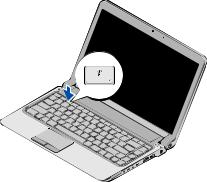
Setting Up Your Studio Laptop
Enable or Disable Wireless (Optional)
10
To turn on wireless, with the computer turned on:
1.Press <Fn><F2> or press the 
 key on the keyboard.
key on the keyboard.
The Wireless icon appears at the bottom right of the screen
2.Select one of the following:
––Enable Bluetooth ––Enable Wireless LAN
––Enable Wireless WAN/GPS 3. Click OK.
To turn off wireless, press <Fn><F2> or press the 
 key on the keyboard.
key on the keyboard.

Connect to the Internet (Optional)
 NOTE: ISPs and ISP offerings vary by country.
NOTE: ISPs and ISP offerings vary by country.
To connect to the Internet, you need an external modem or network connection and an Internet service provider (ISP).
 NOTE: If an external USB modem or WLAN adapter is not a part of your original order, you can purchase one from the
NOTE: If an external USB modem or WLAN adapter is not a part of your original order, you can purchase one from the
Dell website at www.dell.com.
Setting Up a Wired Connection
•If you are using a dial-up connection, connect the telephone line to the external USB modem (optional) and to the telephone wall connector before you set up your Internet connection.
•If you are using a DSL or cable/satellite modem connection, contact your ISP or cellular telephone service for setup instructions
Setting Up Your Studio Laptop
To complete setting up your wired internet connection, follow the instructions in “Setting Up Your Internet Connection” on page 12.
Setting Up a Wireless Connection
 NOTE: To set up your wireless router, see the documentation that shipped with your router.
NOTE: To set up your wireless router, see the documentation that shipped with your router.
Before you can use your wireless Internet connection, you need to connect to your wireless router.
To setup your connection to a wireless router:
1.Save and close any open files, and exit any open programs.
2.Click Start  → Connect To.
→ Connect To.
3.Follow the instructions on the screen to complete the setup.
11

Setting Up Your Studio Laptop
Setting Up Your Internet Connection
To set up an Internet connection with a provided ISP desktop shortcut:
1.Save and close any open files, and exit any open programs.
2.Double-click the ISP icon on the Microsoft Windows® desktop.
3.Follow the instructions on the screen to complete the setup.
If you do not have an ISP icon on your desktop or if you want to set up an Internet connection with a different ISP, perform the steps in the following section.
 NOTE: If you cannot connect to the Internet but have successfully connected in the past, the ISP might have a service outage. Contact your ISP to check the service status, or try connecting again later.
NOTE: If you cannot connect to the Internet but have successfully connected in the past, the ISP might have a service outage. Contact your ISP to check the service status, or try connecting again later.
 NOTE: Have your ISP information ready. If you do not have an ISP, the Connect to the Internet wizard can help you get one.
NOTE: Have your ISP information ready. If you do not have an ISP, the Connect to the Internet wizard can help you get one.
12
1.Save and close any open files, and exit any open programs.
2.Click Start  → Control Panel.
→ Control Panel.
3.Under Network and Internet, click Connect to the Internet.
The Connect to the Internet window appears.
4.Select either Broadband (PPPoE) or Dial-up, depending on how you want to connect:
•Choose Broadband if you will use a DSL, satellite modem, cable TV modem,
or wireless technology connection.
•Choose Dial-up if you will use an optional USB dial-up modem or ISDN.
 NOTE: If you do not know which type of connection to select, contact your ISP.
NOTE: If you do not know which type of connection to select, contact your ISP.
5.Follow the instructions on the screen and use the setup information provided by your ISP to complete the setup.
Setting Up Your Studio Laptop
13
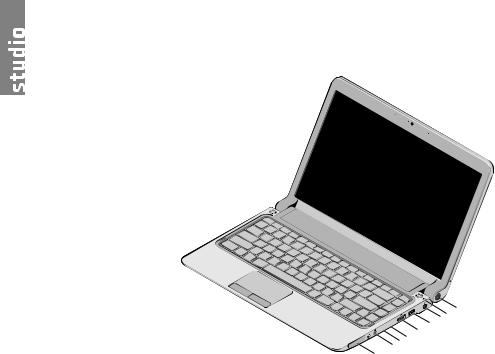
Using Your Studio Laptop
Your Studio 14z laptop has indicators buttons that provide information
to perform common tasks. The your computer provide the option additional devices.
Right Side Features
1
 23 4 5 6 78 9
23 4 5 6 78 9
14

1

 ExpressCard slot/8-in-1 Media Card Reader adapter – Provides support for additional memory, wired and wireless communications, multimedia, and security features. Supports 34 mm ExpressCards. If you have ordered an 8-in-1 media card adapter, it is installed in the slot. If not, the computer ships with a plastic blank installed in the slot.
ExpressCard slot/8-in-1 Media Card Reader adapter – Provides support for additional memory, wired and wireless communications, multimedia, and security features. Supports 34 mm ExpressCards. If you have ordered an 8-in-1 media card adapter, it is installed in the slot. If not, the computer ships with a plastic blank installed in the slot.
The 8-in-1 memory card reader adapter reads the following digital media memory cards:
•Secure Digital (SD) memory card
•MultiMediaCard (MMC)
•MMC+
•Memory Stick
•Memory Stick PRO
•xD-Picture Card
Using Your Studio Laptop
•Hi Speed-SD
•Hi Density-SD
 NOTE: The plastic blank or media card adapter installed in the ExpressCard slot protects unused slots from dust and other particles. Save the blank or media card adapter for use when no ExpressCard is installed in the slot. Blanks from other computers may not fit your computer.
NOTE: The plastic blank or media card adapter installed in the ExpressCard slot protects unused slots from dust and other particles. Save the blank or media card adapter for use when no ExpressCard is installed in the slot. Blanks from other computers may not fit your computer.
15

Using Your Studio Laptop
2

 Audio out/Headphone connectors (2) – Connects one or two pairs of headphones, or sends audio to a powered speaker or sound system. The audio signal is the same for both connectors.
Audio out/Headphone connectors (2) – Connects one or two pairs of headphones, or sends audio to a powered speaker or sound system. The audio signal is the same for both connectors.
3

 Audio in/Microphone connector –
Audio in/Microphone connector –
Connects to a microphone or inputs signal for use with audio programs.
4


 IEEE 1394 connector – Connects to high-speed serial multimedia devices, such as digital video cameras.
IEEE 1394 connector – Connects to high-speed serial multimedia devices, such as digital video cameras.
5 eSATA/USB combo connector with USB PowerShare – Connects to eSATA compatible storage devices (such as external hard disk drives or optical
eSATA/USB combo connector with USB PowerShare – Connects to eSATA compatible storage devices (such as external hard disk drives or optical
drives) or USB devices (such as a mouse, keyboard, printer, external drive, or MP3 player).
16
The USB Powershare feature allows you to charge USB devices when the computer is powered on/off or in sleep state.
 NOTE: Certain USB devices may not charge when the computer is
NOTE: Certain USB devices may not charge when the computer is
powered off or in sleep state. In such cases, turn on the computer to charge the device.
 NOTE: If you turn off your computer while charging an USB device, the device will stop charging. To continue charging, disconnect the USB device and connect it again.
NOTE: If you turn off your computer while charging an USB device, the device will stop charging. To continue charging, disconnect the USB device and connect it again.
 NOTE: The USB PowerShare is automatically shut off when only 10% of the total battery life remains.
NOTE: The USB PowerShare is automatically shut off when only 10% of the total battery life remains.
6

 USB 2.0 connector – Connects to USB devices, such as a mouse, keyboard, printer, external drive, or MP3 player.
USB 2.0 connector – Connects to USB devices, such as a mouse, keyboard, printer, external drive, or MP3 player.

7

 AC adapter connector – Connects to the AC adapter to power the computer and charge the battery.
AC adapter connector – Connects to the AC adapter to power the computer and charge the battery.
8

 Battery status light – Turns on steadily or blinks to indicate the battery charge status. The light indicates the following states when the computer is powered by
Battery status light – Turns on steadily or blinks to indicate the battery charge status. The light indicates the following states when the computer is powered by
the battery:
•No light – The battery is adequately charged.
•Solid amber – The battery charge is low.
the AC adapter:
•Solid amber – The battery is charging.
•Solid white – The battery is almost fully charged.
•Off – The battery is fully charged.
Using Your Studio Laptop
9

 Power button and light – Turns the computer on or off when pressed. The light in the button indicates the following power state:
Power button and light – Turns the computer on or off when pressed. The light in the button indicates the following power state:
•Solid white – The computer is on.
•Blinking white – The computer is in standby mode.
•Off – The computer is off.
17
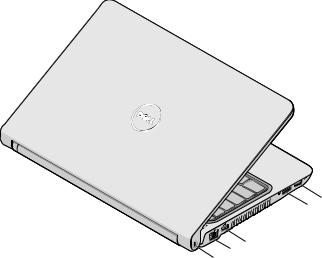
Using Your Studio Laptop
Left Side Features
4 5
1 2 3
18

1Security cable slot – Attaches a commercially available antitheft device to the computer.
 NOTE: Before you buy an antitheft device, ensure that it works with the security cable slot on your computer.
NOTE: Before you buy an antitheft device, ensure that it works with the security cable slot on your computer.
2

 Network connector – Connects your computer to a network or a broadband device if you are using a wired network.
Network connector – Connects your computer to a network or a broadband device if you are using a wired network.
3

 USB 2.0 connector – Connects to USB devices, such as a mouse, keyboard, printer, external drive, or MP3 player.
USB 2.0 connector – Connects to USB devices, such as a mouse, keyboard, printer, external drive, or MP3 player.
4



 DisplayPort connector – Digital interface standard connector that supports external DisplayPort monitors and projectors.
DisplayPort connector – Digital interface standard connector that supports external DisplayPort monitors and projectors.
Using Your Studio Laptop
5

 HDMI connector – Connects to a TV for both 5.1 audio and video signals.
HDMI connector – Connects to a TV for both 5.1 audio and video signals.
 NOTE: When used with a monitor, only the video signal is read.
NOTE: When used with a monitor, only the video signal is read.
19
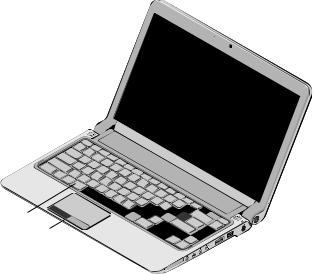
Using Your Studio Laptop
Computer Base and Keyboard
Features
1




 2 3
2 3 



20

1Keyboard/Backlit keyboard (optional) –
If you have purchased the optional backlit keyboard, the F6 key has the backlit keyboard icon 

 on it. The optional backlit keyboard provides visibility in dark environments by illuminating all symbols on the keys.
on it. The optional backlit keyboard provides visibility in dark environments by illuminating all symbols on the keys.
For more information on using the keyboard, see the Dell Technology Guide.

 Backlit keyboard brightness settings
Backlit keyboard brightness settings
–Press <Fn><F6> key to toggle the three lighting states (in the given order):
a.half keyboard brightness
b.full keyboard brightness
c.no lighting
2Touch pad buttons – Provide leftand right-click functions like those on a mouse.
Using Your Studio Laptop
3Touch pad – Provides the functionality of a mouse to move the cursor, drag or move selected items, and left-click by tapping the surface.
It supports scroll, zoom, and rotate features. To change the settings, doubleclick the Dell Touch pad icon in the notification area of your desktop.
21
